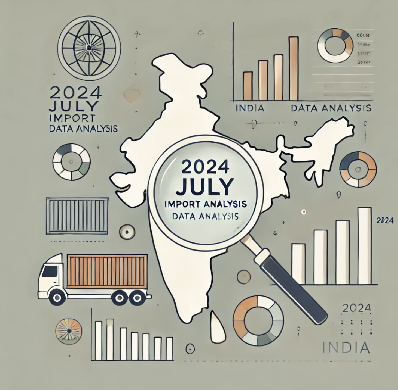Ghana Customs Import Data Update: June 2024 Analysis Report
Overview
In June 2024, Ghana's customs import data showed significant changes. Through detailed statistics and analysis from NBD Data, we have identified some key trends and insights in Ghana's international trade. This report will delve into these data changes, covering overall statistics, major product categories and their import data, key imports from China, and Ghana's major trading regions.
I. Overall Data Statistics
In June 2024, Ghana recorded a total of 160,884 import data entries, a decrease of 30.26% compared to last month's 230,682 entries, and a decrease of 15.80% compared to the same period last year's 191,063 entries. The total import value for this month was $1.184 billion, a decrease of 39.38% month-over-month but an increase of 20.12% year-over-year. The number of buyers and suppliers also showed significant changes, with a total of 8,493 buyers this month, a decrease of 19.38% month-over-month and 37.12% year-over-year; the total number of suppliers was 8,549, a decrease of 23.83% month-over-month and 39.66% year-over-year.
These data reflect some fluctuations in Ghana's international trade, potentially influenced by the global economic environment, supply chain tensions, and changes in market demand.
II. Major Imported Products Analysis
The major product categories imported by Ghana in June 2024 are as follows:
Mineral Fuels and Oils (HS Code 271019): The total import value for this category was $317.98 million, a decrease of 16.56% month-over-month but an increase of 3597.04% year-over-year. The significant growth in this category indicates a substantial increase in Ghana's energy demand.
Other Mineral Fuels and Oils (HS Code 271012): The total import value for this category was $225.93 million, a decrease of 36.01% month-over-month but an increase of 89106.27% year-over-year. Despite the significant month-over-month decrease, the substantial year-over-year growth reflects an increased demand for diverse energy sources.
Liquefied Natural Gas (HS Code 271113): The total import value for this category was $37.53 million, an increase of 29.81% month-over-month and 107.98% year-over-year. The growing popularity of liquefied natural gas as an alternative energy source is evident in Ghana.
Cereals (HS Code 110429): The total import value for this category was $27.30 million, an increase of 231.31% month-over-month and 67.31% year-over-year. The significant increase in cereal imports likely meets the rising domestic food demand.
Engineering Machinery (HS Code 842952): The total import value for this category was $22.92 million, a decrease of 34.16% month-over-month but an increase of 56.41% year-over-year. Despite the month-over-month decline, the year-over-year growth indicates an increasing demand for infrastructure development.
III. Key Imports from China
The top five product categories imported from China to Ghana and their statistics are as follows:
Engineering Machinery (HS Code 842952): The total import entries for this category were 145, with a total value of $11.13 million, a decrease of 40.33% month-over-month and an increase of 62.53% year-over-year.
Pesticides and Similar Products (HS Code 380893): The total import entries for this category were 70, with a total value of $9.94 million, a decrease of 62.34% month-over-month and a decrease of 53.74% year-over-year.
Plastics and Articles Thereof (HS Code 390769): The total import entries for this category were 12, with a total value of $4.07 million, an increase of 248.60% month-over-month and a decrease of 25.00% year-over-year.
Other Engineering Machinery (HS Code 842951): The total import entries for this category were 74, with a total value of $3.98 million, an increase of 14.70% month-over-month and an increase of 1357.94% year-over-year.
Processed Foods (HS Code 200290): The total import entries for this category were 29, with a total value of $3.96 million, a decrease of 64.58% month-over-month and an increase of 60.50% year-over-year.
These data indicate that China plays a crucial role in Ghana's import market, particularly in engineering machinery and pesticides.
IV. Major Trading Regions Analysis
The major trading regions for Ghana in June 2024 and their statistics are as follows:
China: The total import entries from China were 66,912, with a total value of $180.33 million, a decrease of 25.82% month-over-month and 16.51% year-over-year. China remains one of Ghana's most important trading partners.
United Arab Emirates: The total import entries were 4,689, with a total value of $97.72 million, a decrease of 39.01% month-over-month and an increase of 378.94% year-over-year.
Netherlands: The total import entries were 5,347, with a total value of $76.27 million, a decrease of 19.48% month-over-month and an increase of 445.20% year-over-year.
Switzerland: The total import entries were 1,773, with a total value of $46.73 million, an increase of 39.73% month-over-month and 1943.32% year-over-year.
United States: The total import entries were 13,150, with a total value of $43.54 million, a decrease of 14.22% month-over-month and 7.95% year-over-year.
Other significant trading regions include India, Latvia, Malta, and Belgium. These data demonstrate that Ghana's trading partners are globally diverse, with different regions playing varying roles in Ghana's import market.
Conclusion
In June 2024, Ghana's import data showed a complex trend of fluctuations. Influenced by the global economic environment, market demand, and supply chain tensions, significant changes were observed in import entries and values. NBD Data will continue to monitor and analyze global trade dynamics, providing clients with the most timely and detailed data information.
Disclaimer: The data and analysis in this report are derived from NBD Data's statistical results and may contain some errors. Users should verify these data independently. NBD Data is not responsible for any consequences arising from the use of this report's information.
For more detailed data, please visit NBD Data's official website: en.nbd.ltd




